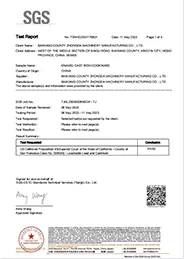
reseasoning cast iron skillet
The Art of Reseasoning a Cast Iron Skillet
Cast iron skillets are a beloved staple in many kitchens around the world, cherished for their durability, heat retention, and the unique flavor they can impart to dishes. However, to maintain their non-stick surface and prevent rusting, they require proper seasoning. The process of reseasoning your cast iron skillet can rejuvenate it, protecting it from the elements and ensuring that it performs optimally for years to come.
Understanding the Basics of Seasoning
Seasoning a cast iron skillet involves creating a layer of polymerized oil, which not only provides a non-stick surface but also protects the skillet from moisture and rust. Over time, this layer can wear down due to regular use, washing, and exposure to high heat. Reseasoning is necessary when you notice food starting to stick, a dull appearance, or any rust spots.
Steps to Reseason Your Cast Iron Skillet
1. Cleaning the Skillet Before you begin the seasoning process, ensure that your skillet is clean. If it has any rust or food residue, scrub it with a stiff brush and hot water. Avoid soap, as it can strip away the existing seasoning. For stubborn spots, you can use a mixture of coarse salt and water to create a paste and scrub until the surface is smooth.
2. Drying Thoroughly After cleaning, it's imperative to dry your skillet completely to prevent any rust from forming. Place it on a low heat on the stove for a few minutes or wipe it down with a dry cloth until it’s fully moisture-free.
reseasoning cast iron skillet

3. Applying Oil Select a suitable oil for seasoning. Good options include flaxseed oil, grapeseed oil, or vegetable oil, which have high smoking points. Apply a thin layer of oil over the entire surface of the skillet, including the handle and the outside. Use a paper towel or cloth to ensure it is evenly coated, avoiding excess oil that can turn sticky.
4. Baking the Skillet Preheat your oven to 450°F (232°C). Place a baking sheet or aluminum foil on the lower rack to catch any drips. Next, place the oiled skillet upside down on the upper rack. Bake it for about one hour. This process allows the oil to polymerize, creating the protective non-stick layer.
5. Cooling Down Once the hour is up, turn off the oven and allow the skillet to cool inside. This gradual cooling process helps prevent cracking or warping.
Maintaining Your Reseasoned Skillet
Now that your skillet is seasoned, maintaining it is key. After each use, simply wipe it down with a paper towel and avoid soaking it in water. If food begins to stick, consider a gentle scrub with a brush and hot water, followed by a light application of oil. Always store your skillet in a dry place, and place a paper towel inside during storage to absorb moisture.
Conclusion
Reseasoning a cast iron skillet is a simple yet rewarding task that can breathe new life into your kitchen tool. With attention and care, your skillet can last for generations, complete with memories of delicious meals. Embrace the process of reseasoning as a celebration of cooking, ensuring every meal is enhanced by the deep, rich flavors that only a well-seasoned cast iron skillet can provide. Happy cooking!
-
Season Cast Iron Perfectly with GPT-4 Turbo TipsNewsAug.01,2025
-
High Quality Cast Iron Cookware - Baixiang County Zhongda MachineryNewsAug.01,2025
-
Premium Cast Iron Pan: Durable & Perfect HeatNewsAug.01,2025
-
High Quality Kitchen Durable Black Round Cast Iron Cookware Pancake Crepe Pan-Baixiang County Zhongda Machinery Manufacturing Co., Ltd.NewsAug.01,2025
-
Cast Iron Cookware - Baixiang County Zhongda Machinery | Nonstick, Heat ResistanceNewsAug.01,2025
-
High Quality Kitchen Durable Black Round Cast Iron Cookware - Baixiang County Zhongda Machinery | Non-Stick, Heat Retention, DurableNewsJul.31,2025


